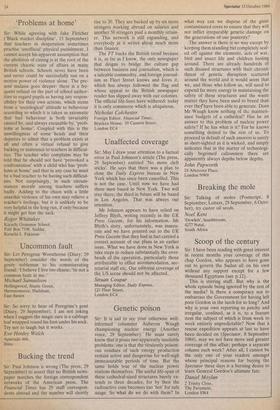Genetic poison
Sir: It is sad to see your otherwise well- informed columnist Auberon Waugh championing nuclear energy (Another voice, 29 September). He must surely know that it poses two apparently insoluble problems: one is that the virulently poison- ous residues of such energy production remain active and dangerous for well-nigh immeasurable periods of time. But the same holds true of the nuclear power stations themselves. The useful life-span of these cathedral-sized structures barely ex- tends to three decades, for by then the radioactive core becomes too 'hot' for safe usage. So what do we do with them? In what way can we dispose of the giant contaminated cores to ensure that they will not inflict irreparable genetic damage on the generations of our posterity?
The answer is there is no way except by keeping them standing but completely seal- ed off against the elements, acts of war, bird and insect life and children fooling around. There are already hundreds of such disused structures with their chronic threat of genetic disruption scattered around the world and it would seem that we, and those who follow us, will need to expend far more energy in maintaining the safety of these structures and the waste matter they have been used to breed than ever thef have been able to generate. Does Mr Waugh know nothing of tho mainten- ance budgets of a cathedral? Has he an answer to this problem of nuclear power safety? If he has what is it? For he knows something denied to the rest of us. To proceed in default of such answers is surely as short-sighted as it is wicked, and simply indicates that in the matter of technologi- cally begrimed callousness there are apparently always depths below depths.
John Papworth
24 Abercorn Place, London NW8






















































 Previous page
Previous page